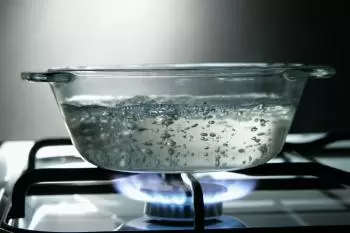
The boiling temperature of pure water at sea level is 212 degrees Fahrenheit.
The temperature at which water boils is called the boiling point and depends on pressure. The more pressure, the higher the boiling temperature. Therefore, it also depends on the height since the atmospheric pressure decreases with increasing altitude.
For example:
-
At sea level, pure water boils at 212 °F. (one atmosphere of pressure)
-
On Everest (8,848 meters high), the liquid boils at 86 degrees Celsius.
-
At an altitude of 19,000 meters, we cause the boiling point to change to 37ºC.
The boiling point of a liquid varies depending on the external pressure. A liquid in a partial vacuum has a lower boiling point than when that liquid is at atmospheric pressure. A high-pressure fluid has a higher boiling point than when that liquid is at atmospheric pressure.
-
When the external pressure is less than one atmosphere, the liquid’s boiling point is lower than its typical boiling point.
-
When the external pressure is equal to one atmosphere, a liquid’s boiling point is called the standard boiling point.
-
When the pressure exerted is greater than one atmosphere, water boil at higher temperatures than its standard boiling point.
Another factor that influences the boiling point of water is the purity of the liquid. Different substances such as mineral salts, calcium, sodium, sulfates, or bicarbonates are dissolved in water. In the same way, these factors also affect the freezing point.
For example, if we add 58 grams of salt to one liter of water, the boiling point increases by 1 degree Celsius.
When the temperature reaches the boiling point, gas bubbles form within the liquid. These bubbles rise to the surface and release the gas into the environment. At the same time, the kinetic energy of its molecules increases.
How does the boiling point affect a thermal solar energy system?
One of the dangers of a solar thermal energy system is that boiling or excessive temperature increases in the heat transfer fluid can occur.
Suppose we choose an organic heat transfer fluid in the primary circuit. In that case, the boiling risk will be zero since its boiling temperature is much higher than 100 ºC, being typical for it to be above 180 ºC.
This margin is more than sufficient for the operating parameters of the DHW installation.
What is the latent heat of vaporization?
The latent heat of vaporization is the necessary heat to convert a certain number of water molecules from a liquid state to a gas.
The heat supplied to the water involves an increase in temperature until it begins to boil. When the water boils, the transition from the liquid phase to the gas phase occurs. During this phase, the water absorbs a certain amount of heat to overcome the attractive forces that hold the atoms or molecules together. During this process, the temperature remains constant until the entire mass has made the change.
By comparison to boiling, sublimation is a physical transformation in which a solid turns directly into vapor. For such compounds, a sublimation point is a temperature at which a solid turning straight into vapor has a vapor pressure equal to the external pressure.
Vapour pressure is a measure of a material’s tendency to change into the gaseous or vapor state.
How does altitude affect cooking?
At higher altitudes, the air pressure is lower, so food takes longer to cook. Cooking at a high altitude requires some special considerations.
There are specific boiling points established in the kitchen, and, therefore, they are distinct in the cooking times of most recipes. Water does not boil at the same temperature in all areas of the world.